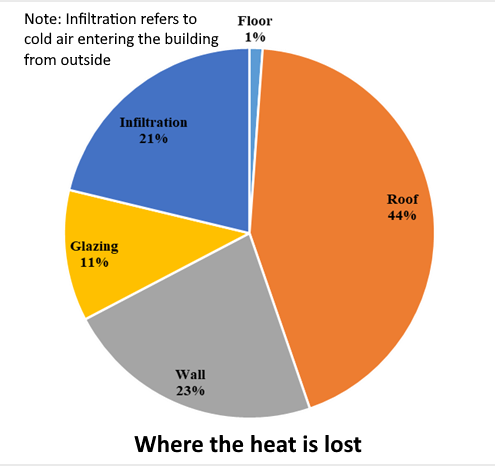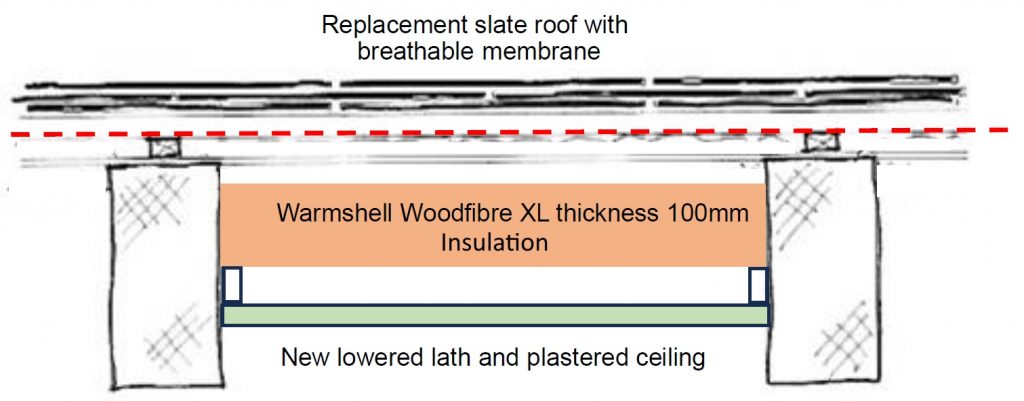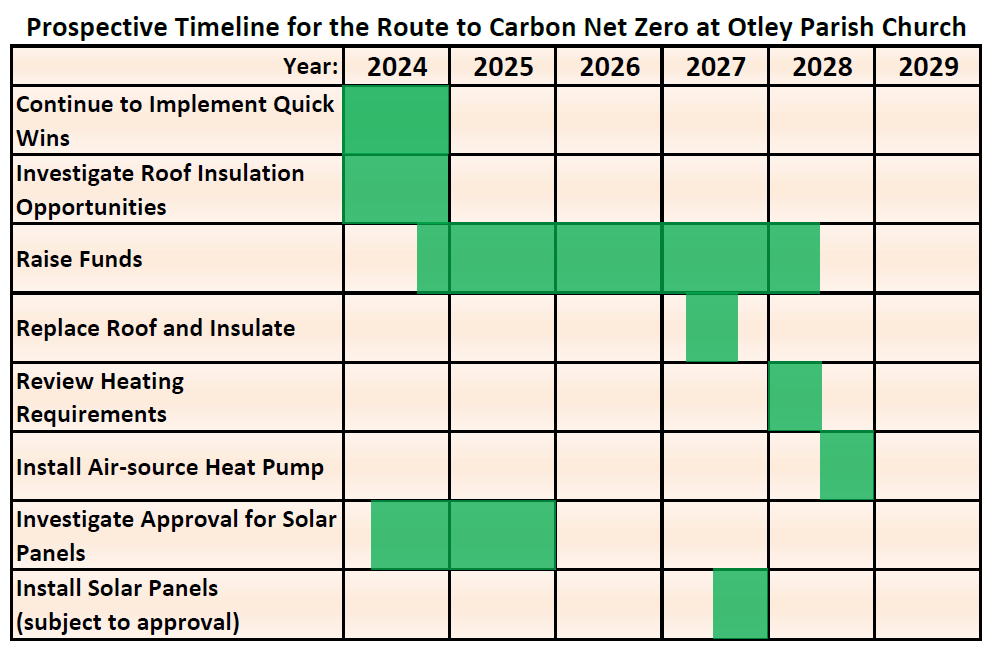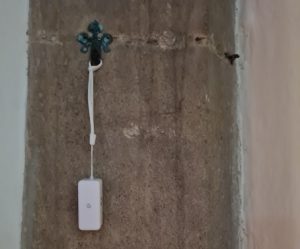Carbon Net Zero 2030
 The Church of England (nationally) has set a target for churches to achieve Carbon Net Zero by the year 2030. This is a big challenge and means moving away from heating the building by gas. In May 2023 Otley Parish Church set up a small group - six people plus Churchwarden - to draw up a roadmap and take action towards this goal.
The Church of England (nationally) has set a target for churches to achieve Carbon Net Zero by the year 2030. This is a big challenge and means moving away from heating the building by gas. In May 2023 Otley Parish Church set up a small group - six people plus Churchwarden - to draw up a roadmap and take action towards this goal.
Progress so far (the blue links go to the relevant documents):
-
The Group undertook research to learn what other churches were doing and to understand our own Carbon Footprint (29 tCO2 in 2023) and the potential for its reduction.
-
Six months of research led to the presentation in November 2023 of the Otley Parish Church ‘Roadmap To Carbon Net Zero’ as a focus for action.
-
A Feasibility Study into replacement and insulation of the church roof has been completed: more details below.
-
We now have an Environmental & Sustainability Policy which underpins the work of the Carbon Net Zero group. We will draw up an action plan now for us to begin implementation of this policy, in which we hope the whole of the Church community will become involved.
-
The CNZ Group have produced a Presentation covering its work so far, the next steps to take and the challenges still faced.
-
We are now exploring grant funding options for the roof replacement and insulation.
Heat Loss From the Building
 Understanding this is key to reducing our energy use, and hence our carbon foorprint. Analysis from gas use data, combined with a spatial model of the building (derived from earlier 3-D imaging) gives an estimate of the likely heat loss routes as shown in this pie chart. This indicates that simply insulating the roof would bring significant benefits.
Understanding this is key to reducing our energy use, and hence our carbon foorprint. Analysis from gas use data, combined with a spatial model of the building (derived from earlier 3-D imaging) gives an estimate of the likely heat loss routes as shown in this pie chart. This indicates that simply insulating the roof would bring significant benefits.
This conclusion is supported by thermal imaging taken on a frosty day in April which shows the north wall and roof from the outside. The lighter colour of the roof, and the associated temperature figures, indicate that the roof is the greatest point of heat loss from the church, with it being about 6 degrees hotter than the walls.
 The nave and aisle roofs which were installed in 1867 (at a cost of £347) are now in a poor state and require replacement. In principle the PCC accepts that the sensible way forward is to use the opportunity of roof replacement (and potentially the ceiling) in the main part of the church building to incorporate insulation to reduce significantly our energy consumption, energy bills and carbon footprint.
The nave and aisle roofs which were installed in 1867 (at a cost of £347) are now in a poor state and require replacement. In principle the PCC accepts that the sensible way forward is to use the opportunity of roof replacement (and potentially the ceiling) in the main part of the church building to incorporate insulation to reduce significantly our energy consumption, energy bills and carbon footprint.
Roof Insulation
In June 2024 the PCC commissioned a roof replacement Feasibility Study by the Church Architect and this was presented to the PCC in November. In the study, the church architect has suggested how insulation could be fitted between the existing roof beams, as illustrated here:

The Feasibility Study gives us an indicative cost approaching £600,000 to replace & insulate the Church roof. This would be a first step towards achieving Carbon Net Zero but obviously will require some major fundraising. A small group of parishioners are working with the CNZ group and the Diocese on a Fundraising Strategy but if you have knowledge or experience in this area, please do get in touch with us via the church office.
Achieving Carbon Net Zero by 2030
Roof insulation is one of the major steps but there are others. The timeline below lists the main actions and when we think they could happen. Note that the timings are speculative and may change as we work through the project:

How much will it cost?
At a rough estimate, replacing the Church roof and insulating it will cost in the region of £600,000. As a Church community we would fund raise from the congregation and look for external grants to support this work. The steps which follow-on would not be as expensive, as we are considering solar panels and changing from gas boilers to an air source heat pump (ASHP). Installing insulation will reduce the energy consumption, solar panels can provide an income stream and will contribute to the running costs of the ASHP. The ASHP delivers the main progress towards Net Zero and solar photo voltaics can be used to achieve the Net Zero target.
We are working with other local bodies, such as Otley 2030, Otley Energy, Otley Town Council, Leeds City Council and the Diocese of Leeds to share benefits and expertise.
What else can we do?
There are some small steps, “quick wins” which can help to reduce the church carbon footprint. Some can be done by volunteers at zero or very little cost. Slightly bigger steps may require professional work.
Already some work has been done by volunteers on cleaning the Parish Room heaters and the ventilation system with its heat recovery unit to improve their efficiency. The heaters are now much more effective and quiet running.

To better understand the heating profile of the church building, we have installed small temperature and relative humidity sensors in the Nave, Chancel, South Transept, Parish Room and Organ Vestry. These feature continuous logging and remote monitoring. If you look carefully, you may be able to spot the sensors. The data from the these will be informative, particularly now that colder weather is here and we are using the heating system more.
Additionally, work in the churchyard on the south side has allowed more sunlight into the church and reduced dampness in the walls. You can read more about this on our
Churchyard Management page.
Some of these steps towards net zero may seem small, but all help to improve the current efficiency of energy use by, for instance, filling in gaps to reduce draughts and regular maintenance of air circulation, ventilation and heating systems, windows, gutters and Churchyard.
What are other Churches doing?
We are encouraged that other churches in the Diocese have already made good progress towards being Carbon Net Zero by 2030;
All Saints Ilkley,
Holy Trinity Skipton,
St Chad’s Far Headingley and
Menston Parish Church to name but four. Our neighbouring churches kindly agreed to site visits so that we could see what they had done so far – you can read about it on their websites via the hyperlinks above. These visits have been useful and have led to recommendations to see more places where the Church of England has reduced its carbon footprint. More recently, we visited
York Minster and were inspired by their vision, commitment and big steps already taken towards carbon net zero. Work is is now complete to fit 184 solar panels on the Minster roof. Read about the blessing of this work at York Minster in
this BBC article.
“
If we can do it, everybody else can do it…” said Alex McCallion, the minster’s director of works and precinct.
We are hopeful that if the Church of England is serious about churches being Net Zero by 2030 they will be flexible in their consideration of our plans here in Otley. Please keep checking back here on the website for updates as we move towards Carbon Net Zero.
If you would like to contact the Carbon Net Zero group please email:
info@otleyparishchurch.org
Find out more
Achieving Net Zero is a long and complicated task. Fortunately, the Church of England has provided many useful documents to help us along the way. Below are links to some of the more accessible documents that we are using.
Diocese of Leeds Toolkit: sustainable Heating in your church:
https://d3hgrlq6yacptf.cloudfront.net/63dac5b59618e/content/pages/documents/dac-heating-toolkit.pdf
The above PDF document includes a link “Church of England – Environmental section” which has lots of useful information and yet more links! The following 2 links seem quite relevant to OPC circumstances:
Roadmap to Net Zero Carbon by 2030:
https://www.churchofengland.org/resources/net-zero-carbon-routemap
There is a long list of Case Studies but this particular one covers a Grade I church (as is Otley Parish Church) with air-source heating and solar panels:
https://www.churchofengland.org/about/environment-and-climate-change/towards-net-zero-carbon-case-studies/low-cost-low-carbon
The following
Diocese of Leeds DAC Environmental Policies and Guidance document is long, but pages
15 to 18 for Heating and
pages 23 & 24 for Solar Panels (etc) are relevant. Whatever the PCC decides to do, the Diocesan Advisory Committee (DAC) will have to approve:
https://www.leeds.anglican.org/dac-sustainability-policy
The following guidance is very detailed and there is a lot of reading in the various sections.
C of E comprehensive guidance on church heating including options appraisal:
www.churchofengland.org/resources/churchcare/advice-and-guidance-church-buildings/heating
Finally, The Diocese of Leeds has produced a
Heating Checklist. Diocese of Leeds Church Heating Checklist
https://d3hgrlq6yacptf.cloudfront.net/63dac5b59618e/content/pages/documents/heating-checklist-july-2022.pdf